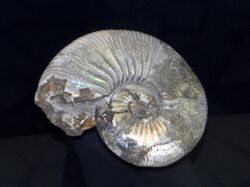Biology:Acanthohoplites
| Acanthohoplites | |
|---|---|

| |
| A. hannoverensis Hannover (Germany ) | |
| Scientific classification | |
| Domain: | Eukaryota |
| Kingdom: | Animalia |
| Phylum: | Mollusca |
| Class: | Cephalopoda |
| Subclass: | †Ammonoidea |
| Order: | †Ammonitida |
| Suborder: | †Ancyloceratina |
| Family: | †Parahoplitidae |
| Subfamily: | †Acanthohoplitinae |
| Genus: | †Acanthohoplites Sinzow, 1908 |
| Species | |
|
See text | |
| Synonyms | |
| |
Acanthohoplites is an extinct genus of ammonites in the family Parahoplitidae that lived in the Aptian and Early Albian stages of the Early Cretaceous.[1]
Taxonomy
The taxonomic position in the Treatise on Invertebrate Paleontology Pt L, 1957 placed the genus into the family Deshayesitidae. Newer classifications have revised that placement and the genus is now included into the family Parahoplitidae.[2] Parahoplites and Hypacanthoplites are similar genera.
Description
These ammonites have a strongly ribbed shell and ammonitic suture. Early whorls are coronate, which later become round, then oval in section. Primary ribs may have swellings (bullae) at the umbilicus or are without. In early stages primary ribs branch mid flank at prominent lateral tubercles. In later stages lateral tubercles are reduced or absent and primary ribs branch simply at the umbilical shoulder or, again, mid flank. Sutural elements are subquadrate with narrow, shallow embayments. The first lateral lobe tends to be symmetrical.
Species
The following species have been described, either as Acanthoplites or Acanthohoplites.[1]
- A. abichi
- A. aschiltaensis
- A. belohasifakaensis
- A. berkleyi
- A. bigoureti
- A. erraticus
- A. hannoverensis
- A. hesper
- A. impetrabilis
- A. interiectus[3]
- A. manerensis
- A. midoensis
- A. mitiensis
- A. paucicostatus
- A. schucherti
- A. soaranensis
- A. teres
- A. trifurcatus
- A. venustus
The species A. nolani was described as Hoplites nolani and later designated the type species of the genus Nolaniceras in 1961, and was subsequently renamed as Nolaniceras nolani.[2]
Distribution
Acanthohoplites has been found in Upper Aptian and Lower Albian sediments in Europe, Central Asia, East Africa, North and South America:[1]
- Río Mayer Formation, Argentina
- Lowell Formation, Arizona
- Paja Formation, Barichara, Colombia[3]
- Grès verts helvétiques Formation, France
- Georgia
- Ochtrup, Germany
- Sardinia, Italy
- Madagascar
- Clansayes and La Peña Formations, Mexico
- Lemgo Formation, Morocco
- Maputo Formation, Mozambique
- Hokodz River Basin, Russia
- Makatini Formation, South Africa
- Lower Greensand Formation, United Kingdom
- Morocoto River, Venezuela
References
- ↑ 1.0 1.1 1.2 Acanthohoplites at Fossilworks.org
- ↑ 2.0 2.1 Bulot, LG; Latil, J-L; Hairabian, A; Fournillon, A (2014). "New insight on the genus Nolaniceras Casey, 1961 (Ammonoidea, Cretaceous) and its consequences on the biostratigraphy of the Aptian Stage". Proceedings of the Geologists' Association 125 (2): 227–232. doi:10.1016/j.pgeola.2013.12.006.
- ↑ 3.0 3.1 Gómez & Salgado, 2017, p.17
Bibliography
- Gómez Guerrero, Manuel Eduardo, and Estefanía Salgado Jáuregui. 2017. Guía para reconocer objetos del patrimonio geológico y paleontológico, 1–44. Servicio Geológico Colombiano. Accessed 2017-10-17.
Further reading
- Arkell,et al., Mesozoic Ammonoidea; Treatise on Invertebrate Paleontology, Part L, Ammonoidea. Geol Soc of America and Univ Kansas press, 1957. R.C. Moore (ed)
- Sepkoski's Online Genus Database
Wikidata ☰ Q3726684 entry
 |

